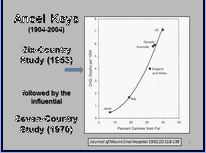
What is a calorie?
In short-it's a measure of energy. The scientific definition is "The energy required to raise 1 gram of water by 1 degree." Okay, you're probably saying, that doesn't help me.
Hold on a second. I'm getting there.
You're interested in losing all that fat that's hanging around your midsection, correct? Then we need to talk calories-specifically, about what they have to do with losing fat.
Ready for the answer?
It's... Absolutely nothing. And counting them doesn't help you lose fat either. Not arm fat, not leg fat, and no-not belly fat.
Whether you're losing weight for health reasons, or you just want to look good, calories have NOTHING to do with your success.
So stop counting them. It's only wasting your time and effort-and possibly even making you gain fat.
Why Calorie Counting Is Making You Fat
Although calorie counting is still one of the most commonly used methods for attempting to lose weight, it is based on a major fallacy.
This is because the idea behind fat-loss models that involve simple calorie counting (ahem, Weight-Watchers) is that all calories are created equal.
The obvious error in this thinking can be easily pointed out even without using science when you simply consider the difference between a 200 calorie 7oz. chicken breast verses a 200 calorie glazed Krispy Kreme doughnut.
One obviously makes you fat, while the other is touted as an essential health food, and rightly so. The difference that you have to consider is the composition of the calories.
The fact is that all calories are made up of different combinations of fat, protein, or carbohydrates. Even within these categories there are quite a few variations, but for the sake of clarity, I'll stick with the basics.
Based upon the composition of the calorie, your body digests and responds to foods differently. For example, it would respond to the 200 calorie Krispy Kreme glazed doughnut by quickly spiking insulin levels and storing fat. Whereas it would respond to eating the 200 calorie 7oz. chicken breast by releasing cortisol and would then proceed to break down the protein into individual amino acids which are transported by various systems of the body to help with tissue repair.

The difference is obviously not the number of calories. It's what those calories are made up of that counts.
To help you understand in a little more depth, I'll show you a real-world example, which consists of comparing two studies that were done about 50 years ago. They are The Ancel Keys Study, performed in 1944 and The John Yudkin Study, performed in the late 1960s.
In the 1944 study, Ancel Keys fed the men in the experiment a diet consisting of 100g Protien, 30g Fat, and 225g Carbs.
The total calories consumed were 1570.
In the 1960 study the men in the experiment were fed a diet consisting of 83g Protien, 105g Fat, and 67g Carbs.
The total calories consumed were 1560.
The interesting part is the comparison of the results:
Although both groups of men were fed essentially the same number of calories-the men in the 1940 study nearly starved to death (literally) while the men in the 1960 study reported "feelings of increased happiness and well-being". They also had no adverse side effects, albeit the low caloric intake.
Obviously, there's something more to fat-loss than the number of calories consumed.

0 comments:
Post a Comment